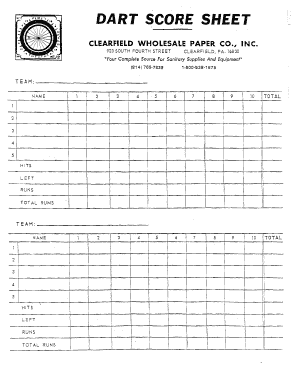Cricket is basically a simple sport. Each team takes its turn to bat (scoring runs) and bowl (getting the opposition batsmen out). The team with the most runs at the end wins. Unless the game is drawn, of course . . . Like any sport that’s been around for a while, cricket has its own laws, legend and language. This Cheat Sheet is here to help.
- Free Cricket Dart Score Sheet
- Cricket Dart Score Sheet Pdf 12 Games
- Cricket Dart Score Sheet Pdf Download
Free Cricket Dart Score Sheet
- Print Blank Dart Tourney Brackets, Seeded and Blind Draw Darts Playoff Matches. Round Robin Schedules. Brackets for all sports and games.
- Cricket is basically a simple sport. Each team takes its turn to bat (scoring runs) and bowl (getting the opposition batsmen out). The team with the most runs at the end wins. Unless the game is drawn, of course. Like any sport that’s been around for a while, cricket has its own laws, legend and language. This Cheat Sheet is here to help.
Player one cricket scoresheet Player two D dartshop 20 19 18 17 16 15 b. Title: Cricket Score Sheet Created Date: 2:00:41 PM. 10+ Cricket Score Sheet Samples, Examples, Templates. It comes in PDF and excel sheet format. It covers all the details, right from batsman to bowler stats.Moreover, you can add details about total visitors, dots, innings score, wickets, total over spelled, wides & NOs and total score in both innings.
Fielding Positions in the Game of Cricket
Don’t know your deep fine leg from your silly mid off? Never fear. This diagram shows you all the commonly used fielding positions in cricket. The figure assumes that a right-handed batsman is standing at the opposite end of the pitch from the bowler.
Umpiring Signals and What They Mean in Cricket
The officials in charge of a game of cricket are called umpires, and they have a whole array of signals to indicate the decisions they make during the course of a game. These are the most important.
Right arm outstretched. No-ball. This signal indicates that the bowler’s foot has landed over the front line of the bowling crease and the delivery is deemed a no-ball.
Both arms outstretched. Wide. This signal shows that the ball was out of reach of the batsman or woman and has been adjudged a wide. One run goes onto the batting team’s extras score, and the ball must be re-bowled.
Right leg raised and clasped by the right hand. Leg byes. This sign indicates that the ball hit the pads of the batsman or woman, not the bat, and that the runs completed are adjudged to be leg byes. These runs are not credited to the individual player’s score but to the team’s, as extras.
Right arm raised skywards. Byes. This shows that the ball has been missed by both the batsman or woman and the wicket-keeper. Any runs scored are deemed to be byes. Byes, like leg byes, are counted as extras.
Right hand and arm swept across the body. Four runs. This signal signifies that the ball has been hit all the way to the boundary. The ball has bounced on its way to the boundary and four runs have been scored.
Both arms held above the head and index fingers outstretched. Six runs. The ball has been hit over the boundary, without the ball bouncing. Six runs are awarded for this fab feat.
Index finger raised towards the batsman or woman. Out. The umpire has given the batsman or woman out and they have to leave the crease and take the long, lonely walk back to the pavilion.
Right arm held at out horizontally then flexed back to touch the shoulder. Short run. One of the batsmen or women has failed to touch their bat down beyond the front line of the bowling crease when going for a run. This is deemed a short run and the scorer is being told to take that run off the score.
The LBW Law Made Simple
For a batsman in a cricket match to be given out leg before wicket (LBW) a strict set of rules apply, to do with where the ball has struck the pitch and then hit the batsman’s pad. This figure takes you through all the possibilities.

International Game Formats for Cricket

International cricket has a variety of the game for everyone, from the five-day tactical tension of the Test match to the bat-swinging fireworks of Twenty20. The following are a few simple clues to help you tell which of the most popular formats is which.
Test match:
Players wear white clothes.
Players use a red ball.
The match is played in daylight.
A match lasts up to five days.
The playing day lasts at least seven hours.
One day match:
Players wear coloured clothes.
Players use a white ball.
The match is often played partly under floodlights.
Most matches start early afternoon.
The playing day lasts about eight hours.
Twenty20 match:
Cricket Dart Score Sheet Pdf 12 Games

Cricket Dart Score Sheet Pdf Download
Players wear coloured clothes.
Players use a white ball.
The match is often played partly under floodlights.
Most matches are played in the evening.
Play lasts just three hours.